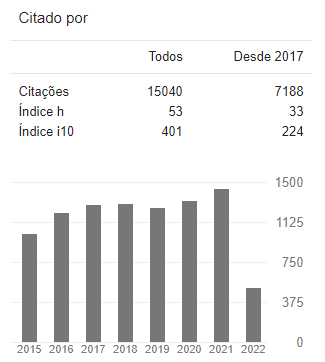Self-selected exercise intensity for inactive hypertensive older women: a pilot study
DOI:
https://doi.org/10.12820/Rbafs.24e0084Palavras-chave:
Exercise, Hypertension, Blood pressure, Physical exertion, AffectResumo
O exercício em intensidade autosselecionada (EIA) é uma abordagem simples para encorajar um estilo de vida ativo. Este estudo investigou se o EIA atende a intensidade recomendada para tratamento de hipertensão (i.e. moderada-vigorosa), e se a frequência cardíaca (FC), percepção de esforço (PSE) e resposta afetiva são reprodutíveis. Treze mulheres idosas hipertensas inativas (idade: 64,54 ± 4,16 anos; pressão arterial: 122,51/62,15 mmHg) realizaram duas sessões de EIA de 30 minutos ao ar livre. FC de reserva (FCR), PSE e resposta afetiva foram avaliadas. Teste t pareado, coeficiente de correção intraclasse (CCI) e erro típico (ET) foram analisados. As participantes se exercitaram em intensidade moderada-vigorosa (≥ 40% da FCR). Não houve diferença na FCR (56,46 ± 8,01% vs. 59,08 ± 10,57%), PSE (11,26 ± 1,14 vs. 10,98 ± 1,52) e resposta afetiva (3,47 ± 1,13 vs. 3,38 ± 1,23; p > 0,05). A PSE apresentou excelente confiabilidade (CCI = 0,82; IC95%: 0,42; 0,94; p = 0,003). Houve baixa confiabilidade da FCR (CCI = 0,40; IC95%: -0,97; 0,82; p = 0,193) e resposta afetiva (CCI = 0,19; IC95%: -2,10; 0,76; p = 0,369). O ET foi de 8,11 bpm, 0,75 e 1,11 para FCR, PSE e resposta afetiva, respectivamente. Em conclusão, mulheres idosas hipertensas inativas parecem atender a intensidade recomendada para tratamento da hipertensão quando realizam EIA e relatam a atividade como leve-moderada e prazerosa. Embora apenas a PSE, e não a FCR e resposta afetiva, tenha mostrado boa reprodutibilidade. Os resultados parecem suportar o EIA como uma abordagem simples para encorajar um estilo de vida ativo nessa população.
Downloads
Referências
World Health Organization. A global brief on Hypertension - World Health Day 2013. World Heal Organ. 2013;39.
Whelton PK, Carey RM, Aronow WS, Casey DE, Collins KJ, Dennison HC, et al. Guideline for the Prevention, Detection, Evaluation, and Management of High Blood Pressure in Adults. Hypertension. 2018;71:e13-e115.
Rissardi GGL, Cipullo JP, Moreira GC, Ciorlia LAS, Cesarino CB, Zanesco A, et al. Prevalence of physical inactivity and ist effects on blood pressure and metabolic parameters in a Brazilian urban population. Int J Cardiovasc Sci. 2018;31(6):594–602.
Pescatello LS, Macdonald HV, Ash GI, Lamberti LM, Farquhar WB, Arena R, et al. Assessing the existing professional exercise recommendations for hypertension: A review and recommendations for future research priorities. Mayo Clin Proc. 2015;90(6):801–12.
Cornelissen VA, Smart NA. Exercise training for blood pressure: a systematic review and meta-analysis. J Am Heart Assoc. 2013;2(1):e004473.
Sosner P, Guiraud T, Gremeaux V, Arvisais D, Herpin D, Bosquet L. The ambulatory hypotensive effect of aerobic training: a reappraisal through a meta-analysis of selected moderators. Scand J Med Sci Sports. 2017;27(3):327–41.
Bueno DR, Marucci MFN, Gobbo LA, Roediger MA, Duarte YAO, Lebrão ML. Expenditures of medicine use in hypertensive / diabetic elderly and physical activity and engagement in walking : cross secctional analysis of SABE Survey. BMC Geriatr. 2017;17:70.
Lind E, Matre RRJ, Ekkekakis P. What intensity of physical activity do previously sedentary middle-aged women select? Evidence of a coherent pattern from physiological, perceptual, and affective markers. Prev Med. 2005;40(4):407–19.
Krinski K, Machado DGS, Lirani LS, Silva SG, Costa EC, Hardcastle SJ, et al. Let’s Walk Outdoors! Self-Paced Walking Outdoors Improves Future Intention to Exercise in Women With Obesity. J Sport Exerc Psychol. 2017;39(2):145–57.
Ekkekakis P, Parfitt G, Petruzzello SJ. The Pleasure and Displeasure People Feel When they Exercise at Different Intensities Decennial Update and Progress towards a Tripartite Rationale for exercise intensity prescription. Sport Med. 2011;41(8):641–71.
Kahneman D, Diener D, Schwarz N. Objective happiness. The foundation of hedonic psychology. 1999;3–25.
Williams DM, Dunsiger S, Ciccolo JT, Lewis BA, Albrecht AE, Marcus BH. Acute Affective Response to a Moderate-intensity Exercise Stimulus Predicts Physical Activity Participation 6 and 12 Months Later. Psychol Sport Exerc. 2008;9(3):231–45.
Ryan E. Rhodes AK. Can the Affective Response to Exercise Predict Future Motives and Physical Activity Behavior ? A Systematic Review of Published Evidence. Soc Behav Med. 2015;49(5):715–31.
Ghadieh AS, Saab B. Evidence for exercise training in the management of hypertension in adults. Can Fam Physician. 2015;61(3):233–9.
Brito LC, Fecchio RY, Peçanha T, Lima AA, Halliwill JR, Forjaz CLM. Postexercise hypotension as a clinical tool: a “single brick” in the wall. J Am Soc Hypertens. 2018;12(12):e59–64.
Costa IBB, Schwade D, Macêdo GAD, Browne RAV, Junior LFF, Freire YA, et al. Acute antihypertensive effect of self selected exercise intensity in older women with hypertension: a crossover trial. Clin Interv Aging. 2019;14;1-12
Tudor-Locke C, Hatano Y, Pangrazi RP, Kang M. Revisiting “how many steps are enough?”. Med Sci Sports Exerc. 2008;40(Suppl 7):S537-43.
Borg G. The Borg RPE Scale. In: Borg’s perceived exertion and pain scales. Champaign, IL: Human Kinetics; 1998;29–38.
Sociedade Brasileira de Cardiologia. 6a Diretrizes de Monitoramento Ambulatotial da Pressão Aterial e 4a Diretrizes de Monitoramento Residencial da Pressão Arterial. Arq Bras Cardiol. 2018;110(Suppl 5).
Hardy CJ, Rejeski WJ. Not What, but How One Feels: The Measurement of Affect during Exercise. J Sport Exerc Psychol. 1989;11(3):304–17.
Garber CE, Blissmer B, Deschenes MR, Franklin BA, Lamonte MJ, Lee IM, et al. Quantity and quality of exercise for developing and maintaining cardiorespiratory, musculoskeletal, and neuromotor fitness in apparently healthy adults: Guidance for prescribing exercise. Med Sci Sports Exerc. 2011;43(7):1334–59.
Ekkekakis P. Let them roam free? Physiological and psychological evidence for the potential of self-selected exercise intensity in public health. Sport Med. 2009;39(10):857–88.
Ding D, Lawson KD, Kolbe-Alexander TL, Finkelstein EA, Katzmarzyk PT, van Mechelen W, et al. The economic burden of physical inactivity: a global analysis of major non-communicable diseases. Lancet. 2016;388(10051):1311–24.
Schallig W, Veneman T, Noordhof DA, Rodríguez-Marroyo JA, Porcari JP, de Koning JJ, et al. The Role of the Rating-of-Perceived-Exertion Template in Pacing. Int J Sports Physiol Perform. 2018;13(3):367–73.
Elsangedy HM, Krinski K, Costa EC, Haile L, Fonteles AI, Silva TL, et al. The rating of perceived exertion is not different at the ventilatory threshold in sedentary women with different body mass indices. J Exerc Sci Fit. 2013;11(2):102–6.
Ekkekakis P. The Dual-Mode Theory of affective responses to exercise in metatheoretical context: II. Bodiless heads, ethereal cognitive schemata, and other improbable dualistic creatures, exercising. Int Rev Sport Exerc Psychol. 2009;2(2):139–60.
Dishman RK, Sallis JF, Orenstein DR. The determinants of physical activity and exercise. Public Health Rep. 1984;100(2):158–71.
Ekkekakis P, Lind E, Vazou S. Affective Responses to Increasing Levels of Exercise Intensity in Normal-weight , Overweight , and Obese Middle-aged Women. Obesity. 2009;18(1):79–85.
Martins LCG, Lopes MVO, Guedes NG, Mendes Nunes MI, Maciel Diniz C, Nunes MM, Diniz CM, Carvalho PMO. Sedentary lifestyle in individuals with hypertension. Rev Bras Enferm. 2015;68(6):697–704.
Groot GCL, Fagerström L. Older adults’ motivating factors and barriers to exercise to prevent falls. Scand J Occup Ther. 2011;18(2):153–60.










